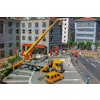Caltrans is highlighting a few transportation infrastructure projects completed in 2013 to help improve mobility, safety and sustainability throughout California’s transportation system.
“From opening new tunnels and bridges to repairing structures damaged by catastrophic fire, Caltrans helped strengthen and preserve California’s great transportation infrastructure,” said California State Transportation Agency Secretary Brian Kelly. “With this work and the emerging active transportation program, Caltrans will remain committed to safety, mobility and sustainability in our transportation system as it heads into the new year.”
Caltrans made nearly $2.5 billion of improvements to the state highway system through 542 completed contracts in 2013 while also awarding 433 major highway construction contracts with a value of more than $2.7 billion. Caltrans also continued to restore, upgrade and protect infrastructure statewide, including more than 88,000 miles of striping on state highways and 155,000 cubic yards of litter and debris removal.
“As 2013 comes to a close, Caltrans is highlighting a small sample of the hundreds of completed infrastructure projects that improved transportation for millions of Californians,” said Caltrans Director Malcolm Dougherty. “In 2014, Caltrans will build on this momentum and continue delivering a safer, more mobile and sustainable transportation system for California.”
Thirteen of the notable 2013 transportation infrastructure projects in California, organized by region, included:
SAN DIEGO
- Otay Mesa East Port of Entry: Caltrans and its partners recently broke ground on the first of three segments of the $717 million State Route 11/Otay Mesa East Port of Entry (POE) Project. Once completed, the four-lane highway will connect about 2.5 miles from SR-905 south to the proposed Otay Mesa East POE at the U.S.-Mexico border. The new freeway will reduce the frequent wait times for commercial trucks at the Otay Mesa POE and for vehicles at the San Ysidro POE.
LOS ANGELES
- Interstate 5/State Route 14 Carpool Connector: Caltrans broke ground on four major highway widening projects on Interstate 5 in 2013 as part of a $1.8 billion effort that will expand this crucial California commerce corridor from six to ten lanes, including a carpool lane in each direction. The new I-5/SR-14 carpool connector reduced travel time for Los Angeles area motorists who can now transition between I-5 and SR-14 without leaving the carpool lane.
- Interstate 5/State Route 2 Tanker Fire Repair: Caltrans worked around the clock to shore up the tunnel at the Interstate 5/State Route 2 interchange in July after a tanker fire caused extensive damage to pavement, walls, support columns, drainage and lighting. Caltrans proceeded with $16.5 million worth of repairs and improvements to fix the damage and increase safety while improving visibility with bright paint and LED lights.
INLAND EMPIRE
- Colton Crossing Project: Caltrans and its partners delivered this rail improvement in Colton south of Interstate 10 eight months earlier than its scheduled 2014 completion and $109 million below the estimated $202 million cost. The concrete overpass speeds up cargo and cuts diesel emissions from waiting trains. The project will save $241 million in travel time and reduce greenhouse gas emissions by 34,000 tons of CO2 equivalent annually.
NORTHERN CALIFORNIA
- Interstate 80 Improvement from Auburn to Nevada: In October, Caltrans finished rebuilding 90 miles of Interstate 80 between Auburn and the Nevada state line. Infrastructure improvements also included rebuilding seven bridges, improving lighting and drainage and adding new traffic monitoring systems. One of California’s critical economic arteries as well as one of the nation’s three continuous coast-to-coast highways, this interstate moves $4.7 million worth of commerce closer to its destination every hour.
- State Route 99 Elverta Road: In the Sacramento area, Caltrans and the County of Sacramento constructed a new interchange at State Route 99 and Elverta Road, which optimized traffic flow and safety for motorists by eliminating one of the last traffic signals along the 40-mile route between Yuba City and Sacramento.
- Rim Fire Repairs to State Route 120: Caltrans employees worked around the clock to reopen State Route 120 into Yosemite National Park after the Rim Fire burned approximately 257,000 acres in late summer. In just 18 days, crews removed more than 1,800 damaged trees, repaired almost 800 guardrail posts and replaced numerous signs to reconnect visitors with this vital link to Yosemite National Park.
CENTRAL VALLEY
- Philip S. Raine Safety Roadside Rest Area: As part of its effort to reduce greenhouse gas emissions and save taxpayer money, Caltrans received Leadership in Energy and Environmental Design (LEED) Platinum certification—the highest possible environmental rating—by the U.S. Green Building Council (USGBC) for the Philip S. Raine Roadside Rest Area on State Route 99 in Tulare County. The Raine facility, one of 233 buildings in California to achieve this milestone, is one hour south of Fresno near Tipton and serves more than four million visitors annually. Caltrans has previously earned LEED Gold certification for its Los Angeles office and LEED Silver certification for the district office in Marysville.
- State Route 99 Madera Rehabilitation: Among the 26 Proposition 1B projects in the State Route 99 Corridor Program, this was Caltrans’ first to use of the “design build” project delivery method that combined design and construction into one contract. Opened on time and on budget, the $37 million project was funded entirely by Proposition 1B and benefits 65,000 commuters, tourists and truckers daily in this critical corridor.
CENTRAL COAST
- State Route 1 Pitkins Curve Bridge and Rockshed Project: In December, a $39 million a permanent slide repair project on State Route 1 along the Big Sur coast in Monterey County was completed to install a bridge and rock shed at Pitkins curve, one of the toughest highway maintenance challenges along California’s central coast. Extensive landslides had occurred on the route, often severing travel on the highway for weeks at a time.
BAY AREA
- Devil’s Slide Tunnels Construction: In March, Caltrans opened the first new highway tunnels in California in nearly 50 years when it cut the ribbon on the Tom Lantos Tunnels, popularly known as the Devil’s Slide Project, which are now the longest tunnels in California. The $439 million project features two 4,200-foot-long tunnels, 32 jet-powered fans for ventilation and 10 fireproof shelters between the tunnels to protect the public.
- San Francisco-Oakland Bay Bridge: In September, Caltrans opened the new San-Francisco-Oakland Bay Bridge, which is designed to withstand the strongest earthquake estimated by seismologists to occur over a 1,500-year period. The new span also includes a bike and pedestrian path that will be extended onto Treasure Island after the old eastern span is removed.
- Fourth Bore of the Caldecott Tunnel: In November, Caltrans opened the new fourth bore of the world-class Caldecott Tunnel on State Route 24, providing two dedicated tunnels in each direction to aid more than 160,000 commuters daily and ending the 50-year-old process of manually reversing the flow of traffic twice per day along the middle bore. The fourth bore has been designated as a regional lifeline structure and is designed to reopen to emergency traffic within 72 hours of a major earthquake.
In addition to these regional achievements, Caltrans reported a decade-high 84 percent pavement health rating in 2013, out of the 50,000 lane miles it maintains. While Caltrans typically receives just 17 percent of the funding needed to keep pavement in good condition, one-time contributions from the voter-approved 2006 Proposition 1B transportation bond and the 2009 Recovery Act made more projects possible.
Caltrans also sold nearly $22 million worth of excess property originally acquired for transportation projects, which was more than $4 million higher than the properties’ estimated market value.
This year, Caltrans also furthered its goal of building a more sustainable transportation system. During the 2012-13 fiscal year, ridership rose to a record 5.6 million passengers on three intercity passenger rail lines funded by the state, and over the past ten years ticket revenues from the three lines have skyrocketed from $44 million to $102 million. Caltrans also released the California State Rail Plan, which lays out a long-term vision for freight and passenger rail. In 2014, Caltrans will build on this momentum by implementing the new Active Transportation Program to fund human-powered transportation projects and programs. The new program is the nation’s largest state commitment to bicycling, walking and other active transportation.













![Fcp Racatac Chair 10893876[1]](https://img.forconstructionpros.com/mindful/acbm/workspaces/default/uploads/2025/10/fcp-racatac-chair-108938761.10l0At5WXv.png?ar=16%3A9&auto=format%2Ccompress&bg=fff&fill-color=fff&fit=fill&h=135&q=70&w=240)
